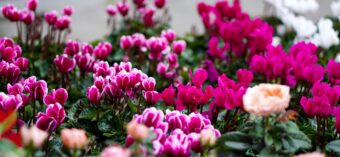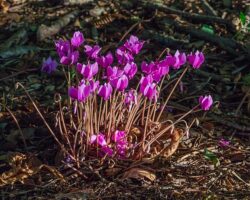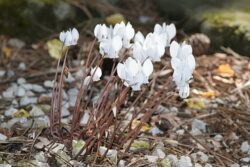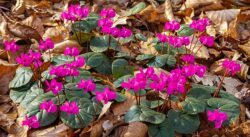In this article, we will discuss how to grow the wonderful colourful corm called Cyclamens in containers. Cyclamens will add beauty to the container garden, where the 20cm tall plants are covered in elegant blooms that are either red, pink, purple or white. You tend to find them on offer as either corms or garden-ready plants that appear in the outdoor patio section of shops.

They are tender cyclamens and hardy cyclamens but as you guess you need to grow the hardy cyclamens to do well outside here in the UK.
The flower with upswept petals are beautiful but the shiny mounds of silvery-green, heart-shaped leaves that appear in autumn add to the appeal of the plant. They first appear in autumn before the leaves disappear in early spring. The species that is often grown outside is Cyclamen hederifolium and Cyclamen coum, whilst the tender Cyclamen persicum is grown as an indoor plant.
It is one plant that looks good as part of a woodland container scheme, where it will look great with Hellebores, Ajugas, Heucheras or Trilliums. Find out how to grow this corm in containers in this article.
GROWING HARDY CYCLAMENS IN CONTAINERS
As said early in this article, cyclamens can be planted as corms directly in containers or you can buy plants in autumn already in bloom and leaf. With the latter you know the colour the blooms are before you buy them, be it white, pink, purple or red but with corms, it is more pot luck (no pun attended).
To grow from corms, you will need to buy the corms in August or September. They are difficult to grow from seed and they will not breed true.
First, select a suitable sized container that is well in proportion with the plant or plants in question and make sure it has plenty of drainage holes.
Fill it with a mix of 30% horticultural grit and 70% multipurpose compost. This is important as it will give the plant good drainage.
Dig a shallow hole and place the corm in, so that the dome end is facing upwards at just below the surface. You can then backfill with the compost and firm it in well. You can place each corm 15cm part. Water well and let the plant to its own devices.
If you are growing garden-ready plants then you can place 3 to 4 plants in a container. All you need to do is dig a hole that is slightly bigger than the root ball it came in the original container. Drop the plant so that the top of the root ball is at the same level as the top of the surface of the compost. Firm the plant in and then water well.

As long as the compost is free-draining the plant will do well and this is why I suggest the gritty growing media.
IT IS EASY TO LOOK AFTER
This is one plant that is easy to look after as it requires little in the way of maintenance. It needs the compost to be moist but never overly wet, which causes the corm to rot. In winter, you will need to water sparling so you may need to bring them in a sheltered location to avoid the compost from getting too wet.
Whilst the plant is in active growth it is best to give a feed every month with a balanced liquid fertilizer until the leaves die back in early spring.
You can divide in late summer, but to get the best show it is advised that you leave the well-established corms alone. They can grow massive and produce hundreds of blooms per year. They may live for many years where it is best to grow them in light shade where too much rain will not be a problem.
PESTS AND DISEASES
Bacterial soft rot and fusarium wilt are diseases that can cause the plant to turn yellow and die. These bacterial and fungal diseases can affect plants severely, where the only course of action is to throw the plant away. To prevent this buy corms from reputable firms and make sure that any containers you use are disinfected with Jeyes fluid.

Botrytis blight will cover the plant with tan spots and grey fungus, which can spread very quickly. The best thing to do is isolate the plant and try to improve air circulation, so that moisture on the leaves and flowers will not be a problem.
Leaf spots can develop on the plant, where yellow, grey or brown, round spots with black dot centres appear on the leaves, Isolate the plant and make sure that watering overhead on top of the leaves and crown is avoided.
Root rots can stunt the plants’ growth, where the corm shrivels and the root turn black and mushy. Nothing can be done when this occurs and the plant will have to be discarded.
If you notice distorted leaves and flowers with abnormal colours, streaks and ring spots, then it is a virus. Discard immediately.
VARIETIES TO GROW

The following are varieties and species of cyclamen to grow outdoor in containers:
This includes Cyclamen hederifolium that has delicate pink, reflexed, swept-back flowers that appear in autumn.
Cyclamen coum has dainty pink flowers that appear later on in winter.
Cyclamen hederifolium ‘Alba’ has white petals with a flush of violet at the centre of each bloom that is produced in winter.
CONCLUSIONS
In this article, we have discussed how to grow Cyclamens in containers and how to succeed. They are easy to grow from corms or shop-bought plants. All that is needed is regular watering, feeding, and little else.
A plant that brings much welcome colour in autumn and winter, where often little else is in bloom.
If you have any questions or comments that you wish to make on growing Cyclamens in containers, please do so in the comment box below.
Happy Cyclamen growing.
